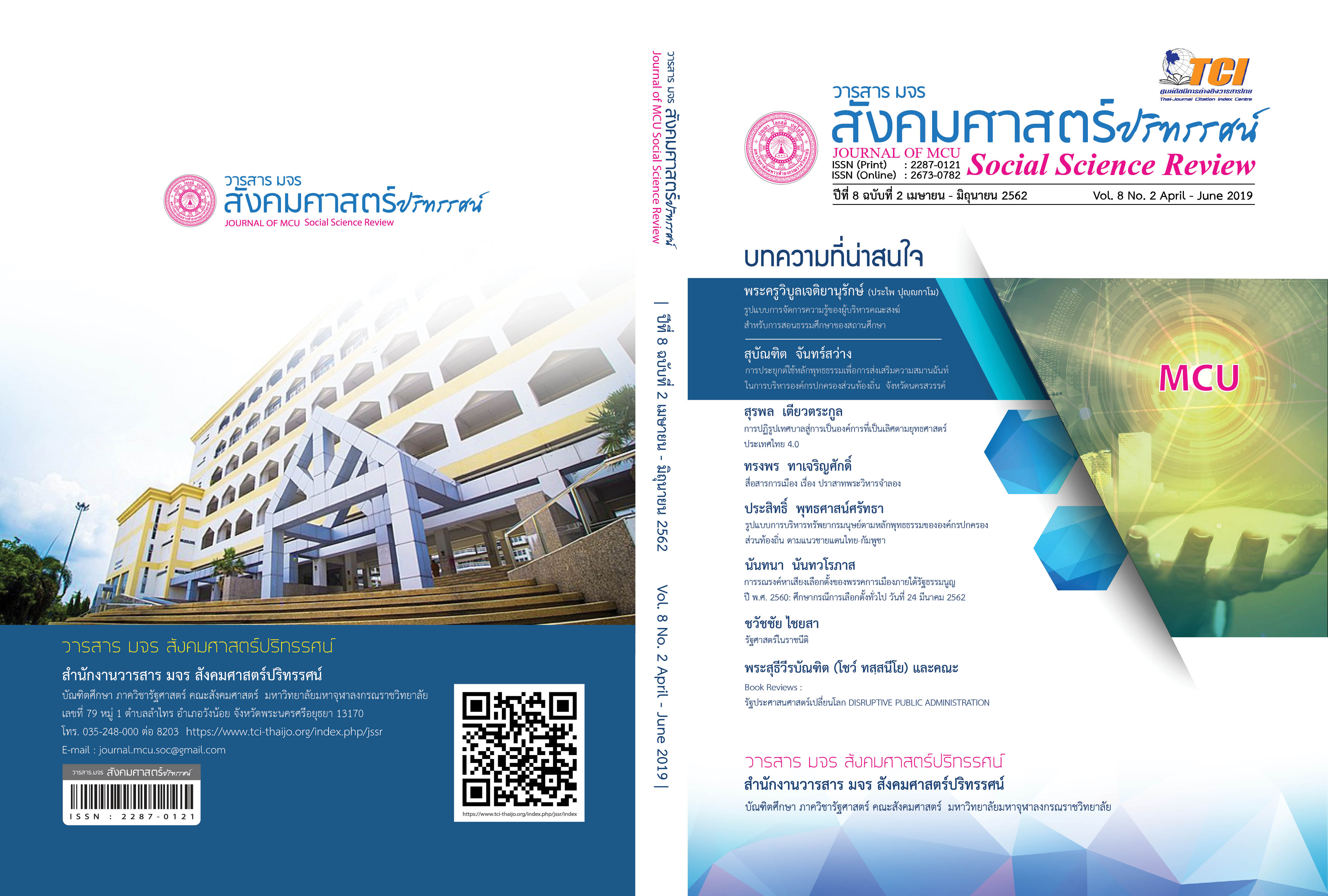รูปแบบการบริหารทรัพยากรมนุษย์ตามหลักพุทธธรรมขององค์กรปกครองส่วนท้องถิ่น ตามแนวชายแดนไทย-กัมพูชา
คำสำคัญ:
รูปแบบ, การบริหารทรัพยากรมนุษย์, พุทธธรรมบทคัดย่อ
บทความวิจัยนี้เป็นการศึกษารูปแบบการบริหารทรัพยากรมนุษย์ตามหลักพุทธธรรมขององค์กรปกครองส่วนท้องถิ่น ตามแนวชายแดนไทย-กัมพูชา การวิจัยในครั้งนี้ ผู้วิจัยมีวัตถุประสงค์เฉพาะ ดังนี้ 1) เพื่อศึกษาวิเคราะห์สภาพทั่วไปของการบริหารทรัพยากรมนุษย์ในองค์กรปกครองส่วนท้องถิ่นชายแดนไทย-กัมพูชา 2) เพื่อการศึกษาบูรณาการแนวคิด ทฤษฎีและหลักพุทธธรรมที่เหมาะสมกับการบริหารทรัพยากรมนุษย์ 3) เพื่อนำเสนอรูปแบบการบริหารทรัพยากรมนุษย์ตามหลักพุทธธรรมขององค์กรปกครองส่วนท้องถิ่นตามแนวชายแดนไทย-กัมพูชา ผลการวิจัยพบว่า 1. ผลการศึกษาวิเคราะห์สภาพทั่วไปการบริหารทรัพยากรมนุษย์ในองค์กรปกครองส่วนท้องถิ่นชายแดนไทย-กัมพูชา พบว่าระบบการบริหารทรัพยากรมนุษย์ขององค์กรปกครองส่วนท้องถิ่นด้านการวางแผน การสรรหาการบรรจุและการคัดเลือก มีประเด็นสำคัญ 2 ประเด็น คือ 1) องค์กรที่ทำหน้าที่บริหารทรัพยากรมนุษย์ให้กับองค์กรปกครองส่วนท้องถิ่นมีหลายหน่วยงาน 2) การทำงานที่ทับซ้อน การจัดโครงสร้างภายในองค์กรและกรอบอัตรากำลัง การกำหนดตำแหน่ง การสรรหา การบรรจุและการแต่งตั้งล่าช้า ด้านการวางคนให้เหมาะกับงาน ผลการวิจัยพบว่า มีประเด็นสำคัญ 2 ประเด็น คือ 1) การรับสมัครในตำแหน่งที่ต้องการ 2) ได้บุคคลที่ไม่ตรงกับความต้องการ ด้านการธำรงรักษาทรัพยากรมนุษย์ ผลการวิจัยพบว่า มีประเด็นสำคัญ 2 ประเด็น คือ 1) หลักสูตรส่วนใหญ่อยู่ส่วนกลาง 2) หลักสูตรอบรมไม่สอดคล้องกับความต้องการที่องค์กรปกครองส่วนท้องถิ่นอยากได้ เช่น ภาษาในท้องถิ่น, วัฒนธรรมท้องถิ่น ด้านการธำรงรักษาทรัพยากรมนุษย์ การวิจัยพบว่า มีประเด็นสำคัญ 2 ประเด็น คือ 1) ข้าราชการหรือพนักงานส่วนท้องถิ่นมีความรู้สึกเป็นข้าราชการชั้นสอง 2) ให้ความเท่าเทียมกันกับข้าราชการพลเรือน 2. ผลการศึกษาการบูรณาการแนวคิด ทฤษฎีและหลักพุทธธรรมที่เหมาะสมกับการบริหารทรัพยากรมนุษย์ คือ ด้านการวางแผน การสรรหาการบรรจุและการคัดเลือก หลักธรรมที่เหมาะสมคือหลักอคติ 4 ด้านการวางคนให้เหมาะกับงาน หลักธรรมที่เหมาะสมคือจริต 6 ด้านการพัฒนาทรัพยากรมนุษย์ ประกอบไปด้วยการพัฒนาและการฝึกอบรมใช้ไตรสิกขา 3 ด้านการธำรงรักษาทรัพยากรมนุษย์ ให้อยู่ในองค์กรนานๆ ใช้หลักธรรมสังคหวัตถุ 4 3. รูปแบบการบริหารทรัพยากรมนุษย์ตามหลักพุทธธรรมขององค์กรปกครองส่วนท้องถิ่นตามแนวชายแดนไทย-กัมพูชา สรุปได้ ดังนี้ รูปแบบของด้านการวางแผน การสรรหาการบรรจุและการคัดเลือก ใช้หลักอคติ 4 รูปแบบด้านการวางคนให้เหมาะกับงาน ด้วยหลักจริต 6 รูปแบบด้านการพัฒนาทรัพยากรมนุษย์ ด้วยไตรสิกขา 3 รูปแบบของด้านการธำรงรักษาทรัพยากรมนุษย์ด้วยสังคหวัตถุธรรม 4
เอกสารอ้างอิง
United Nation. Seminar on Central Service to Local Authorities. Newyork :
Department of Economic and Social Affairs, 1964.
. Decentralization for National and Local Government. New york : Department of Economic and Social Affairs, 1963.
. Local Government in Selected Countries. New york : Department of Economic and Social Affairs, 1964.
M. Wayne Mondy & Robert M. Noe. Human Resource Management. printed 4th.. New Jersey, 2005.
(2) Thesis
Al-Habil, Wasim. “Occupations, a Diaspora, and the Design of Local Government for
a Palestinian State”. Doctor of Philosophy. Cleveland State University, 2008.
Cho, Im-Gon. “Local government fiscal impacts on wages, housing values,
and household migration”. Doctor of Philosophy. Ohio State University, 1997.
Christopher M. Harris. “Strategic Human Resource Management at The Crossroads : Relationship among Human Resource Capital, Overlapping Tenure, Behaviors, and Performance”. Doctor of Philosophy. The University of Texas, 2009.
Crossa, Veronica. “Entrepreneurial urban governance and practices of power : renegotiating the historic center and its plaza in Mexico City”.
Doctor of Philosophy. Ohio State University, 2006.
Dass,KTed K.. “Human Resource Processes and the Role of the Human Resources Function
during Mergers and Acquisitions in the Electricity Industry”. Doctor of Interdisciplinary Studies. University of Cincinnati, 2008.
Dudas, Andrew M.. “The Use of Community Opinion Surveys in Local Government Strategic Decision Making”. Doctor of Philosophy. Miami University, 2005.
Ervin Conover, Theresa. “Policing in the Suburbs: Assessing Wilson’s Theory of Local Political Culture”. Doctor of Education. University of Cincinnati, 2009.
Holian, Matthew John. “Studies in the political economy of local Government”. Doctor of Philosophy. Ohio State University, 2008.
Leemornsiri, Nantawut, Joseph. “The perceptions of human resource professionals in five Thai banks about the human resource development competencies and programs used during the merger and acquisition process”.
Doctor of Philosophy. Ohio State University, 2005.
Lin Yi – chun. “The perceptions of human resource development professionals in Taiwan regarding their working relationships with subject matter experts during the training design process”.
Doctor of Philosophy. Ohio State University, 2006.
Molloy, Janice C.. “Bridging Micro and Macro Human Resource Management through Human Capital Research”. Doctor of Philosophy. Ohio State University, 2008.
Moon, Sanghyun. “Constructing Governance in Global Electronic Commerce”.
Doctor of Philosophy. Ohio State University, 2002.
Rauterkus, Andreas. “Banks as Shareholders : Conflict of Interest Or Efficient Corporate Governance ? the Case of Germany”. Doctor of Business Administration : Finance. University of Cincinnati, 2002.
Stuart, Terrence Ramon. “A Study of the Relationship between Self-perceived Presidential Leadership Style and the Level of Faculty Satisfaction
withKKSharedKKGovernanceKKatKKSelectKKCommunityKKColleges”.Doctorof Philosophy. Ohio University, 2012.
Yu, Minna. “Analyst Activity and Corporate Governance: A Global Perspective”. Doctor of Business Administration. Kent State University, 2007.
Willis, Carla. “Changing the Local Government Regime : The Role of Race in Attaining Substantive Representation”. Doctor of Philosophy. Ohio State University, 2010.
ดาวน์โหลด
เผยแพร่แล้ว
รูปแบบการอ้างอิง
ฉบับ
ประเภทบทความ
สัญญาอนุญาต
ลิขสิทธิ์ (c) 2019 วารสาร มจร สังคมศาสตร์ปริทรรศน์

อนุญาตภายใต้เงื่อนไข Creative Commons Attribution-NonCommercial-NoDerivatives 4.0 International License.
เพื่อให้เป็นไปตามกฎหมายลิขสิทธิ์ ผู้นิพนธ์ทุกท่านต้องลงลายมือชื่อในแบบฟอร์มใบมอบลิขสิทธิ์บทความให้แก่วารสารฯ พร้อมกับบทความต้นฉบับที่ได้แก้ไขครั้งสุดท้าย นอกจากนี้ ผู้นิพนธ์ทุกท่านต้องยืนยันว่าบทความต้นฉบับที่ส่งมาตีพิมพ์นั้น ได้ส่งมาตีพิมพ์เฉพาะในวารสาร มจร สังคมศาสตร์ปริทรรศน์ เพียงแห่งเดียวเท่านั้น หากมีการใช้ภาพหรือตารางหรือเนื้อหาอื่นๆ ของผู้นิพนธ์อื่นที่ปรากฏในสิ่งตีพิมพ์อื่นมาแล้ว ผู้นิพนธ์ต้องขออนุญาตเจ้าของลิขสิทธิ์ก่อน พร้อมทั้งแสดงหนังสือที่ได้รับการยินยอมต่อบรรณาธิการ ก่อนที่บทความจะได้รับการตีพิมพ์ หากไม่เป็นไปตามข้อกำหนดเบื้องต้น ทางวารสารจะถอดบทความของท่านออกโดยไม่มีข้อยกเว้นใดๆ ทั้งสิ้น





